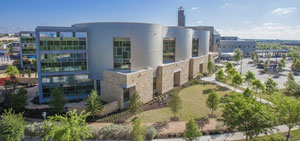In 2008, Dell Children’s Medical Center of Central Texas became the first hospital to earn LEED-Platinum certification and it’s done it again.
Since then, in 2011, the US Green Building Council (USGBC) launched LEED for Healthcare (LEED-HC) to focus specifically on that sector.
And the hospital’s addition, the W.H. and Elaine McCarty South Tower, is the first to earn LEED for Healthcare -Platinum certification.

"This achievement is credited to our committed team of leaders who believe in providing better care for their patients through green building practices and our collaborative project team that believes in integrated, mission-driven design. It’s a powerful one-two punch that results in a healthy, high-performance healing environment. At Dell Children’s, we recognize that healthy environments have a profound, measurable effect on the healing process," says Michele Van Hyfte, Manager of Environmental Stewardship in an USGBC blog.
At 76,000-square-feet, the $48 million addition expands patient capacity by 40% as well as its services, such as units for monitoring epilepsy and acute pediatric rehabilitation. There’s an outdoor healing garden and a therapy gym.
LEED for Healthcare certification has seven categories: site development; water efficiency; energy & atmosphere; materials & resources; indoor air quality; innovation and regional priority credits, which include on-site renewable energy and storm water design.
Hospitals in particular, have huge energy costs because they operate 24 hours a day, 365 days a year. Hospitals use twice the energy of a typical building and spend nearly $8.8 billion on energy each year, according to US Energy Information Administration (EIA).
The hospital earned 86 out of 110 possible points for the new addition, scoring highest for "Sustainable Sites" and optimized energy performance. It got 6 of 6 possible points on Innovation for avoiding persistent bioaccumulative toxic chemicals, such as dioxins and Halogenated Organic Compounds associated with the life cycle of building materials, she says. They also avoided chemicals in building materials, such as phthalates.
They achieved 96% diversion of construction waste from landfills and sourced 73% sustainable products, including all furniture and medical furnishings.
The hospital is located on a brownfield site and has a combined heat and power plant, and solar PV and hot water.
Van Hyfte says the design has improved staff recruiting and retention rates in addition to providing an outstanding healing environment for patients.
The healthcare industry is responsible for 16% of US GDP and 8% of total US greenhouse gas emissions, according to research published in JAMA, the Journal of the American Medical Association, and is second only to the food industry in the waste it generates.
Another innovative hospital is Palomar Medical Center in San Diego.
Read our article, Greening Hospitals Would Cut Health Care Costs.

